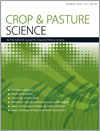In order to determine the importance of awn photosynthesis on grain yield under terminal drought, six two-rowed cultivars of barley representing high yielding commercial releases from 1961 to 2006 were studied in a glasshouse experiment at CSIRO, Western Australia. The cultivars were grown with and without watering from anthesis. Detailed measurements of plant water status, awn, flag and penultimate leaf photosynthetic rate were made from anthesis. At final harvest, biomass, yield and yield components were measured. Awn net photosynthesis rate (Pn) was lower than penultimate and flag leaf and decreased gradually after anthesis. The rate of decreasing Pn was rapid under terminal drought. There was no difference in awn Pn among cultivars under well-watered conditions, but under terminal drought the awn Pn of barley cultivars Baudin and Clipper decreased faster than Vlaming, Gairdner and Stirling. Surface area of awns in each cultivar was higher than the flag and penultimate leaf. Thus, total awn photosynthesis under both well-watered and terminal drought conditions was higher than flag leaf photosynthesis. In Vlaming, total awn photosynthesis was higher than penultimate leaf photosynthesis. Grain yield of the cultivars Baudin, Covette and Gairdner was affected by terminal drought, but grain yield did not correlate with awn total photosynthesis. Under well-watered conditions awn Pn had a significant negative correlation with ear weight. We suggest that under terminal drought, higher awn area does not lead to higher grain yield because sink size may be the factor limiting grain yield in barley.
How to translate text using browser tools
16 July 2012
Photosynthesis of barley awns does not play a significant role in grain yield under terminal drought
Shahab Maddah Hosseini,
Kazem Poustini,
Kadambot H. M. Siddique,
Jairo A. Palta
ACCESS THE FULL ARTICLE
<
Previous Article
|

Crop and Pasture Science
Vol. 63 • No. 5
August 2012
Vol. 63 • No. 5
August 2012
gas exchange
photosynthetic activity
source sink relations
two-rowed barley
water relations





